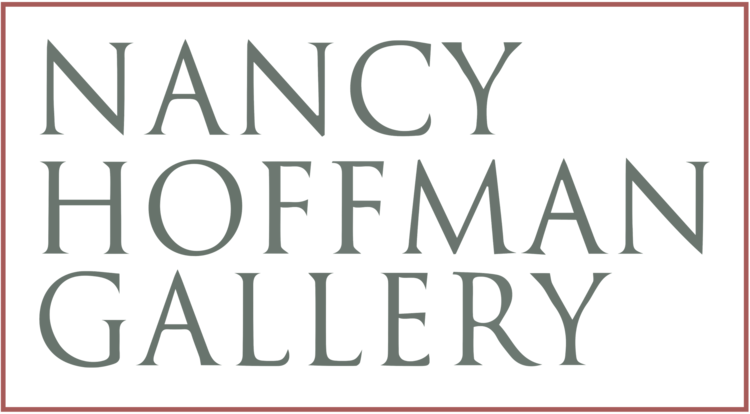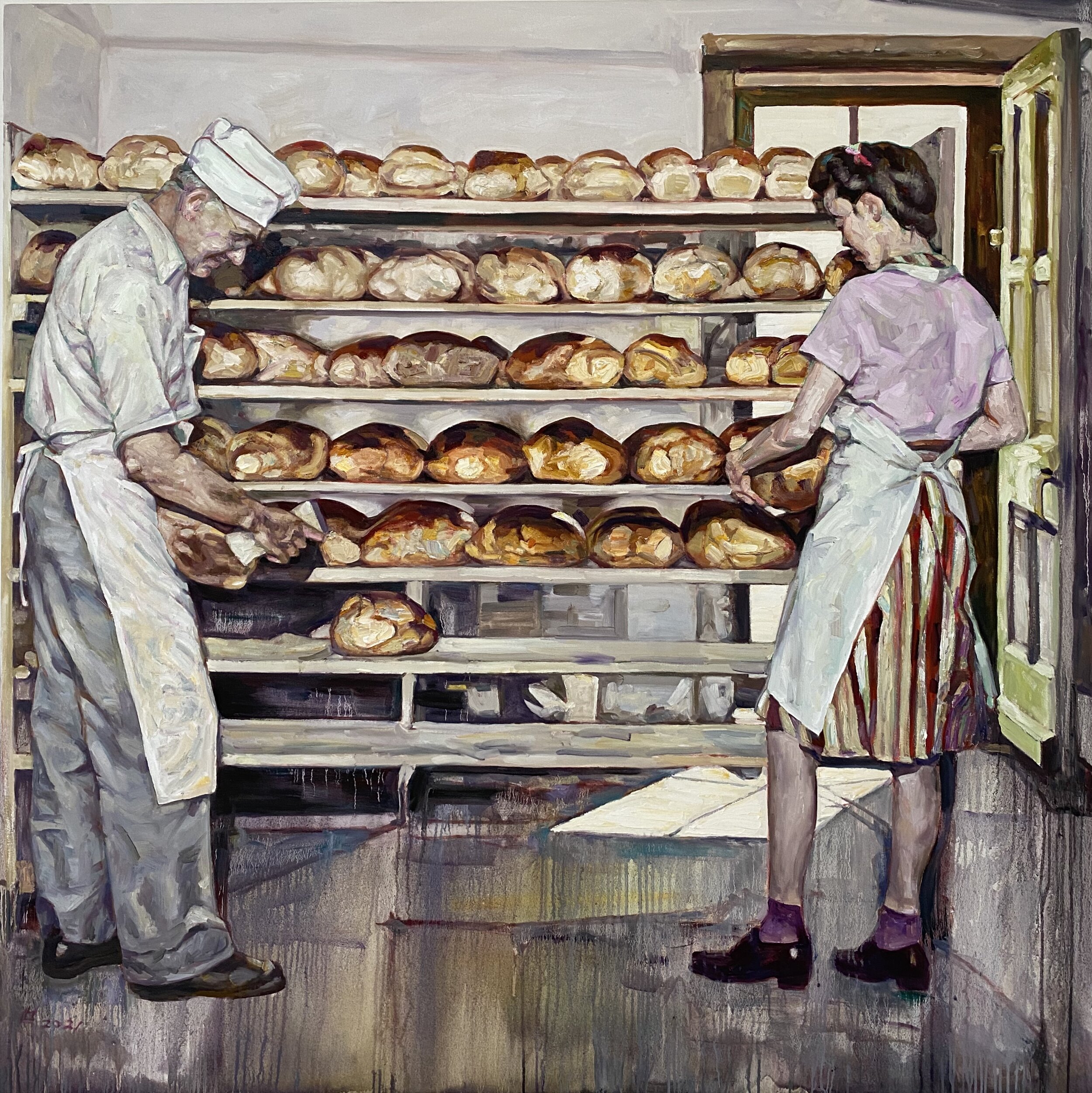Hung Liu
Western Pass, 1990 - 2021
September 9 through December 4, 2021
Western Pass: 1990 – 2021
Paintings by Hung Liu at Nancy Hoffman Gallery
Hung Liu, born in 1948, has lived half her life in China and half her life in America. Having passed through the birth of the People’s Republic of China, the Great Leap Forward, the Cultural Revolution, and China’s Open Door Policy, Liu - already an artist in Beijing - made her passage to California in 1984 to attend graduate school at the University of California San Diego. Her intention, she said, was “to become a better artist.”
Since the 1980s Liu has gazed - through historical photographs that she turns into contemporary paintings - back upon her homeland while looking critically at the multiracial democracy all around her. Known primarily for such subjects as Chinese prostitutes, revolutionary heroines, orphans, migrants, and refugees, she has also turned her attention through the photographs of Dorothea Lange to American refugees of the 1930s, of the Dustbowl and Great Depression.
As a way of marking this passage between two great and brutal societies - and to echo “Hung Liu: Portraits of Promised Lands,” Liu’s retrospective exhibition at the National Portrait Gallery in Washington, DC (August 2021—May 2022) - Nancy Hoffman Gallery is pleased to present “Hung Liu - Western Pass: 1990 - 2021,” a small but refined look at her paintings of the last three decades.
Throughout her career, Liu has drawn her subjects from the lenses of historical photography, including the staged Orientalism of the 19th century (young prostitutes and dynastic courtesans) and, primarily, the social realism of the 20th (refugees, orphans, and peasants). While the majority of her works constitute an extended homage to the common people of her homeland, her paintings of the last six years have focused almost exclusively on the individuals and families ennobled in Dorothea Lange’s photographs.
In “Hung Liu - Western Pass: 1990 - 2021,” four paintings depict Chinese subjects, and five American. “Postmaster” and “Mail Carrier,” for instance, both from 2021, depict a man sitting in front of a small-town post office and a woman delivering mail along a city street. Conceived and painted during the pandemic and political seasons, the idea of mail as a contagion of information in a democracy rises to mind. “Kern County,” 2019, a large canvas, shows an outdoor classroom with small children sitting on the ground as a kindly teacher shows them how to hold an inflated ball. For Liu, the ball is a globe; on it, she has painted the state of California. Another ball, with another small child, depicts Oklahoma, from where they came.
The painting “Western Pass,” 1991, is an arched canvas with silver-leafed box shelves inserted into its surface, breaking the plane of visual illusion and offering the painting as a shrine or altarpiece. “Western Pass” depicts two prisoners about to be executed in public, one gazing vacantly at the camera lens, while between them written in fluid Chinese characters is an ancient poem: “You’re better have another glass of wine, because when you pass beyond the western pass, you won’t have any friends.” Resting on each box is an empty ceramic wine bowl.
Over the past three decades, Liu has evolved a personal style that, with its characteristic drips, washes, and calligraphic circles, stands as a critique of the rigid academicism of the Chinese Socialist Realism in which she was trained, while also opening a fertile, empathic space for the representation of ordinary people caught up in epic, historical, often tragic circumstances.
Hung Liu was born in Changchun, China in 1948. She grew up in Beijing during the revolutionary era of Mao Zedong. In 1968 she was sent to the countryside for four years during the Cultural Revolution where she worked with peasants in rice, wheat, and cornfields seven days a week. During this time, she photographed local farmers with their families and also made drawings of them. After returning from the countryside, she entered the Revolutionary Entertainment Department of Beijing’s Teachers College to study art and education. In 1979 Liu attended the Central Academy of Fine Arts where she majored in mural painting. In 1980 she applied to the Visual Arts graduate program at the University of California, San Diego. After being accepted, it took Liu four years to obtain a passport from the Chinese government. She arrived in California in October 1984.
A two-time recipient of a National Endowment for the Arts Fellowship in painting, Liu has exhibited throughout the nation and beyond. A retrospective of her work, “Summoning Ghosts: The Art and Life of Hung Liu,” was organized in 2013 by the Oakland Museum of California, and toured nationally through 2015. In a review of that show, the Wall Street Journal called Liu “the greatest Chinese painter in the US.” Liu’s works have been exhibited extensively and collected by the San Francisco Museum of Modern Art, the Whitney Museum of American Art, the Nelson Atkins Museum and the Kemper Museum, Kansas City, the Dallas Museum of Art, the Denver Art Museum, the Palm Springs Art Museum, the National Gallery of Art, the National Museum of American Art, and the National Museum of Women in the Arts, Washington, D.C., the Asian Art Museum and the De Young Museum of San Francisco, as well as the San Jose Museum of Art, among others. Liu currently lives in Oakland, California. She is Professor Emerita at Mills College, where she has taught between 1990 and 2014. Liu is currently having an exhibition entitled “Hung Liu: Golden Gate” at the de Young Museum in San Francisco, on view through March 13, 2022. She will be honored with a retrospective, “Hung Liu: Portraits of Promised Lands” at the National Portrait Gallery, Smithsonian Institution, Washington, D.C. on view August 27 through May 30, 2022. Liu is the first Asian American to have a solo show at the National Portrait Gallery.
For further information and/or photographs please call 212-966-6676 or e-mail Nancy Hoffman Gallery at info@nancyhoffmangallery.com.
Yours sincerely,
Nancy Hoffman
ABOUT THE ARTIST
Hung Liu was born in Changchun, China in 1948. She grew up in Beijing during the time of communist force, Mao Tse-tung, the Cultural Revolution, Tiananmen Square. After graduating from high school in 1968, she was sent to the countryside where she worked with peasants seven days a week in the rice and wheat fields, over a four-year period
During this time she photographed and drew portraits of local farmers and their families. In 1972 schools in China began to reopen and Liu entered the Revolutionary Entertainment Department of Beijing’s Teachers College to study art and education. She graduated in 1975 and began teaching art at the Jing Shan School, an elite Beijing school. She also began weekly art lessons for children on television. Her program “How to Draw and Paint,” was renowned, and lasted several years. In 1979 she was accepted to China’s two leading art schools; she chose the Central Academy of Fine Arts where she majored in mural painting.
In 1980 she applied to the visual arts graduate program at the University of California at San Diego. She was accepted in 1981. Her passport was delayed until 1984 when she departed Beijing and began her graduate studies. In 1991 she returned to China for the first time and discovered a treasure of turn of the century photos of Chinese prostitutes, which became source material for her paintings.
Hung Liu’s unusual biography infuses her work with a unique richness; her paintings are steeped in Chinese culture, contemporary and ancient. While she has a foot in both cultures—China and the United States—her art is born of a traditional Chinese art education. She fuses images from 7th Century Tang tomb mural paintings of princes and princesses with Western imagery such as St. Christopher carrying a baby across the river, surrounded by her signature circles of color, an abstract pattern which dances energetically across the surface.
Liu plumbs the depths of her life experience as well as all that interests her about history, gender, identity, Chinese politics and culture and combines this broad range with her intelligence into compositions that pose questions while offering a moment to stop and contemplate all that is bold and beautiful in her universe























